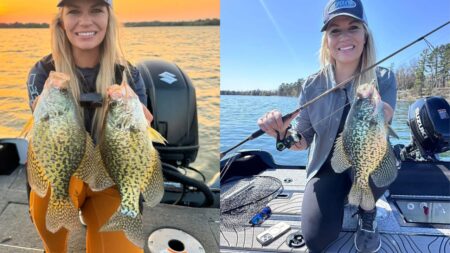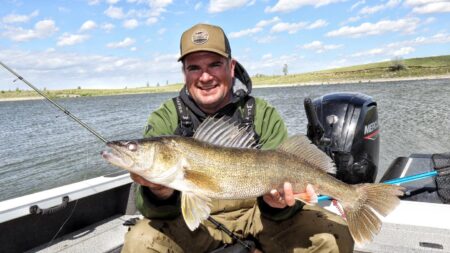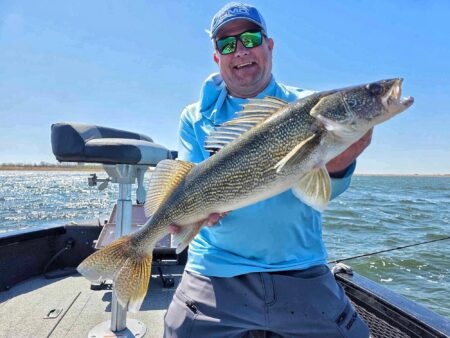Regardless of whether you do a lot of ice fishing or are completely new to it… bluegills are seemingly designed for entertaining ice anglers. Abundant, relatively easy to find, and great on the table, bluegills are one of the most popular species to target for many ice anglers in many states. If you enjoy eating a fresh meal of fish, chances are that bluegill are high on your list. If you hope to introduce somebody new to ice fishing… bluegills are perfect. As common and easy bluegill can be to find and target, the irony is that big bluegills are as difficult to find and catch as any other trophy fish. This is what makes ice fishing bluegill so infatuating and addicting. Bluegill are a fish that can start the passion and are also a fish that experienced anglers continue to target. Ice anglers simply love bluegills.

From the emails we receive to the messages sent to us on social media, what is apparent in the world of Covid 19 is the simple fact that more people are fishing today and more people want to learn about fishing. With so many different activities compromised or outright canceled, there are many people who once fished and now want to get back to fishing. There are also many people who have never fished and want to start. There are also many people who want to take their kids or families out fishing. Fishing is good for people and as a fishing community, we embrace these new anglers with open arms.
More people interested in fishing is good for fishing. It’s good for the industry and ultimately good for the resource. More people fishing means more funding for conservation and access. More people fishing means more interest in policy and legislation that can ultimately affect everything from water quality to public use priorities. The beauty of the North American wildlife management model is that the water and fish are public domain managed for the public. The land might indeed be owned by private individuals but if you have public access to get on the water or ice, that water itself is public domain accessible by anybody who has the correct license. Note as well that resident fishing licenses in most states are amazingly cheap when you look at the number of days you can fish and factor what other recreation costs. In most states, kids can simply fish for free. There is also a critical mass needed for influencing the policy that ultimately affects our fishing opportunities. We need more anglers who care about our resources.
Develop a passion for fishing. Appreciate and respect the resource, so you become an ambassador of this wonderful recreation. Give more than you take and learn sound management practices like selective harvest. Don’t feel like you have to keep a limit of fish just because it is legal but keep simply what you need. Care enough to pick up litter that you see.
If you are just starting, ice fishing bluegill can seem technical and even overly complicated. Some people might be intimidated because they might not have a lot of equipment. Don’t be intimidated. At the end of the day, a bluegill has a brain the size of a peanut. What makes fishing so much fun for so many people is that anybody can get good at fishing or experience some level of success. In fact, some of the best ice anglers don’t necessarily have a lot of equipment… they just know what to do and where to do it.

To accelerate the learning curve, do some research online whenever possible. If you don’t have a lot of equipment, choose lakes that have high densities of fish and look for lakes that have relatively clear water. Why? Because clear water allows you to sight fish where you can often literally watch the fish. Some of the absolute best winter bluegill anglers I have ever seen cut their teeth by sight fishing. At early ice before there is a lot of snow on the ice, look for weeds frozen into the ice. Simply walk out to the edge where the weeds dissipate or disappear so that you are on the outside edge of the weed line. That edge is a high percentage starting point. Many new anglers might start out with a hand auger because of price, and a hand auger can be particularly useful at early ice but electric augers in particular are so easy to use and lightweight that many more women are embracing ice fishing. You don’t need to be a lumberjack to drill a hole with today’s equipment.
To sight fish effectively, a shelter is useful for blocking the light so you can see down the hole. If you are taking a few kids along, hub shelters are affordable and very functional. Check out the C Series Hub Shelters from Clam Outdoors. They offer a lot of room and protect you from the elements. Being able to stare down the hole and watch fish is simply addicting. On many lakes, you will not only see bluegill but also bass, pike, perch or crappie depending on the lake. On most lakes, fish will hang around this outside edge of a prominent weed line for a good portion of the winter. These spots are easy to find.

Once you get started, you will definitely want a flasher for seeing your lure and the fish, but you can get started sight fishing and add the flasher as you continue to acquire equipment. The best bang for the buck in my mind is a Vexilar FL-18 on a Genz Pack. This unit will do everything that you need. The FL-8 is also a great unit that will do everything the FL-18 will do without the zoom feature which is fine if you only plan to target panfish.
When ice fishing bluegill, picking easy high percentage locations is crucial. This is because you must be over the top of fish in order to catch them. However, the next most important component is your presentation. Rods don’t have to be expensive to catch fish. Choose a light action rod with a spring bobber or noodle tip if the goal is panfish like bluegills. Use a lighter line like two-pound CPT Mono and use small jigs like a CPT Drop Jig in a size 8. The CPT Drop Jigs are tungsten which makes them a little more expensive than traditional lead jigs but the tungsten will be much easier to feel on the rod tip. Tip the jig with a waxworm. Use a Palomar knot which can be learned from simply searching on YouTube. Make sure the knot is straight so the jig hangs balanced and horizontal.

Work the jig slowly down to the fish and try to remain slightly above the fish if you can see them. The jigging movements don’t have to be big or drastic. Simply quiver the jig and pause. Quiver and pause until the fish comes up and eats. Small floats can also be used which can be useful especially for kids. If the spring bobber drops or the float moves, set the hook.
For simply learning the basics and especially for introducing kids to the magic of ice fishing, simply getting over the top of a big school of bluegill is perfect. The fish don’t have to be the biggest. For new anglers, the goal when ice fishing for bluegill is to simply catch some fish and check an “X” next to the win column. Get that experience. As you move along in your respective ice fishing career, you may want to target other species or target bigger fish, but you must first lay down the foundation. You have to generate an infatuation and interest. What is most exciting to me is the number of women, for example, that are planning on taking their kids ice fishing. The number of people who might not fit the mold as your prototypical ice angler. That is exciting because I know how great fishing is for people. There would be fewer problems in the world if more people took their kids out fishing. Enjoy the journey!




